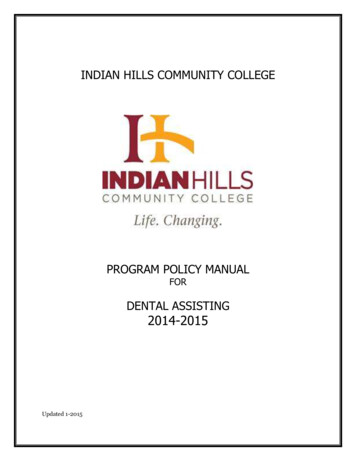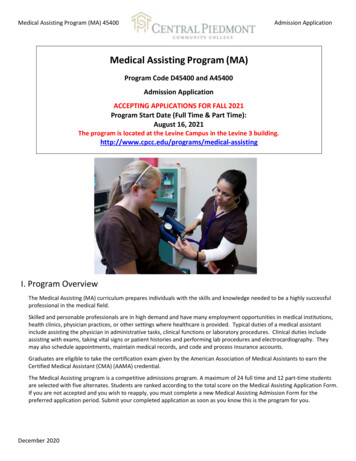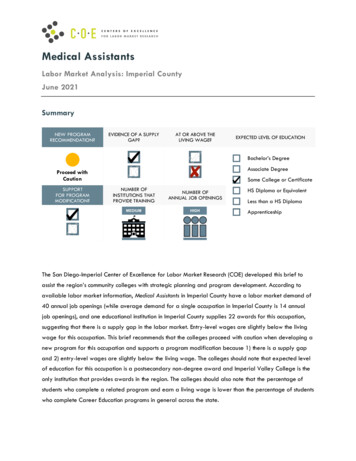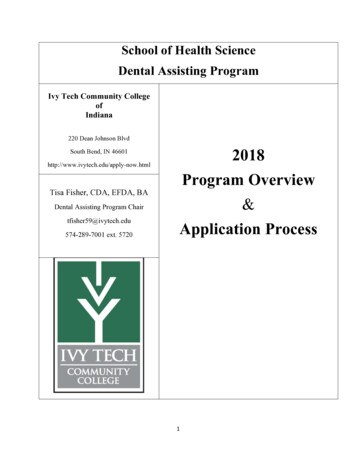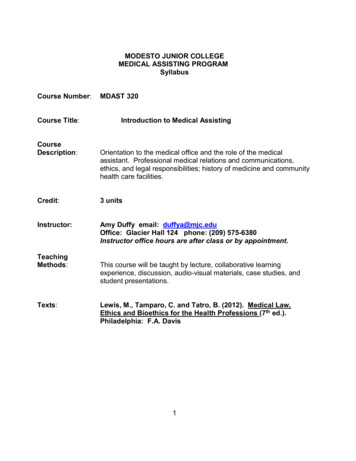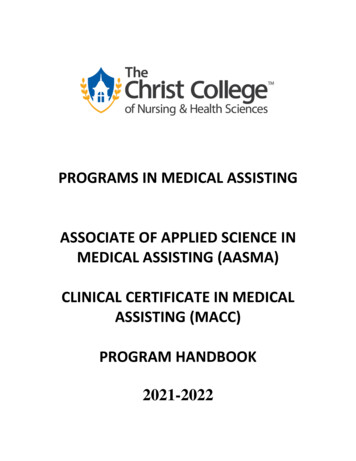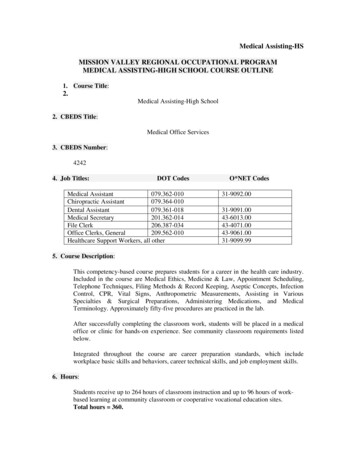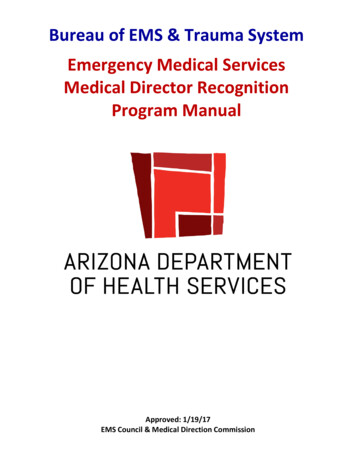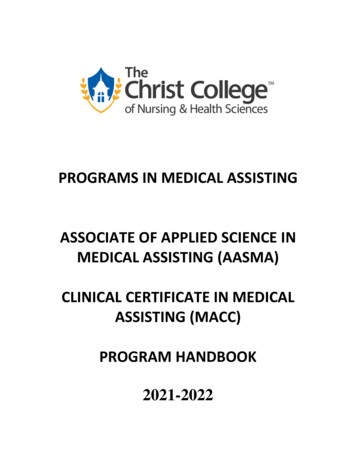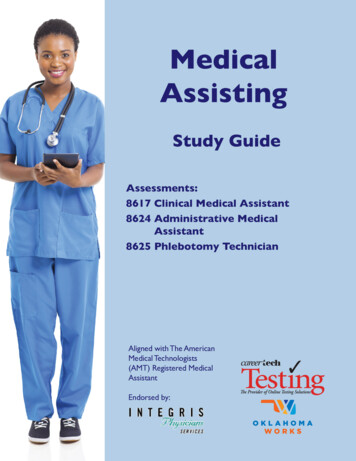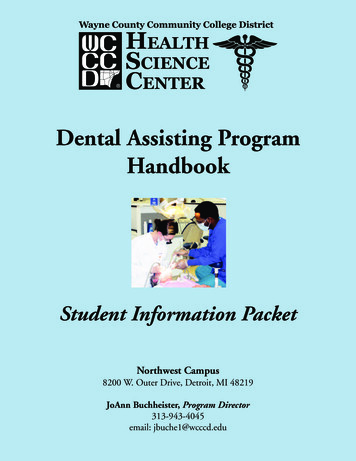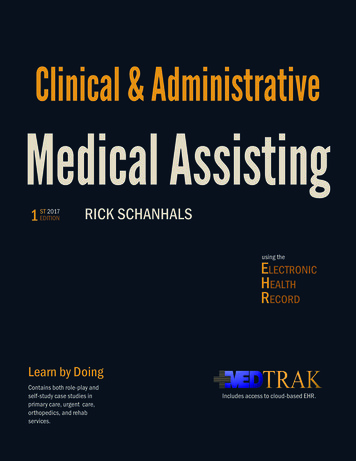
Transcription
Clinical & AdministrativeMedical Assisting1ST 2017EDITIONRICK SCHANHALSusing theELECTRONICHEALTHRECORDLearn by DoingContains both role-play andself-study case studies inprimary care, urgent care,orthopedics, and rehabservices.Includes access to cloud-based EHR.
Software licensed by:ADePT Electronic Solutions, LLCDevelopment Lab1847 Ruddiman DriveNorth Muskegon, MI 49445AuthorRick SchanhalsCHTS-CP, CHTS-PWBSE Industrial Engineering, BSE MathematicsUniversity of Michigan, College of EngineeringEditorDavid A. BlaszakBS MathematicsMichigan State UniversityPublications with integrated MedTrak usage include:Published by ADePT Electronic Solutions, LLC — written by Rick SchanhalsMedical Clinic Workflow 5th Edition (2017)Billing and Reimbursement 5th Edition (2017)Clinical and Administrative Medical Assisting (2017)Care Pathways 4th Edition (2014)Published by Elsevier Inc.ePractice Kit for Medical Front Office Skillswritten by Carol Buck MS, CPC, CPC-H, CCS-P (2011)Electronic Health Record for the Physician’s Officewritten by Amy DeVore CMA (AAMA), CPC (2011)Electronic Health Records - Understanding the Medical Office Workflowwritten by Rick Schanhals BSE IE and Mathematics , CHTS-CP, CHTS-PW (2013)Copyright 2017 - ADePT Electronic Solutions, LLC
ContentsPreface(January 2017) . . . . . . . . . . . . . . . . . . . . . . . .Logging into MedTrakv. . . . . . . . . . . . . . . . . . . . . . . . viiChapter 1Medical Assisting11Chapter 2Meaningful Use. . . . . . . . . . . . . . . . . .23Chapter 3Patient Demographics . . . . . . . . . . . . . . .31Chapter 4Patient Payers . . . . . . . . . . . . . . . . . . . .57Chapter 5Communications . . . . . . . . . . . . . . . . . .85Chapter 6Managing Schedules . . . . . . . . . . . . . . . . 135Chapter 7Scheduling New Patients . . . . . . . . . . . . . 167Chapter 8Scheduling Established Patients . . . . . . . . . 207Chapter 9Scheduling - Changing Appointments . . . . . . 239Chapter 10Registering New Patients . . . . . . . . . . . . . 279Chapter 11Clinic Status ScreenChapter 12Patient Intake . . . . . . . . . . . . . . . . . . . 349Chapter 13Order Entry . . . . . . . . . . . . . . . . . . . . 405Chapter 14Open Orders ProcessingChapter 15Provider Scribing . . . . . . . . . . . . . . . . . 463Chapter 16Patient Discharge . . . . . . . . . . . . . . . . . 493Chapter 17Payment Collection . . . . . . . . . . . . . . . . 529Chapter 18. . . . . . . . . . . . . . . 343. . . . . . . . . . . . 433Registering Established Patients. . . . . . . . . 551Chapter 19Patient Intake . . . . . . . . . . . . . . . . . . . 581Chapter 20Order Entry . . . . . . . . . . . . . . . . . . . . 607Chapter 21Open Orders Processing . . . . . . . . . . . . . 617Chapter 22Provider Scribing . . . . . . . . . . . . . . . . . 629Chapter 23Patient Discharge . . . . . . . . . . . . . . . . . 655Chapter 24Payment Collection . . . . . . . . . . . . . . . . 685Chapter 25Incomplete Messages . . . . . . . . . . . . . . . 705Copyright 2017 - ADePT Electronic Solutions, LLCContents. . . . . . . . . . . . . . . . .
This page intentionally left blank.Copyright 2017 - ADePT Electronic Solutions, LLC
PrefaceWhat is this book about?The goal of this text is to provide medical assistant students the knowledge and skills needed to bea professional asset to a medical facility by completing a series of case studies. Students use thesecase studies in conjunction with MedTrak’s cloud based integrated electronic health record andpractice management system.The case studies are taken from real-life situations and are specifically designed to present relevantcontent and kinesthic practice skills that the medical assistant will need to understand and knowhow to do when they join the health care workforce.Medical Assisting Responsibilities - both administrative and clinicalPrefaceMedical Office PrinciplesUnderstanding Revenue Cycle Management - scheduling through payments and collectionsUnderstanding the Basics of Medical Workflow - integrated EHR and practice managementUnderstanding Meaningful Use - what it is and why it is importantCommunicationsHandling Incoming Calls - from patients and other related partiesManaging the Medical Facility and Provider Schedules - by blocking out the unavailable timesGroup Health including Primary CareScheduling Appointments - for both new and established group health patientsRegistering Patients - for primary care, rehab services, and orthopedicsPatient Intake - obtaining the patient’s preliminary history, body statistics, and vital signsComputerized Provider Order Entry (CPOE) - placing orders for x-rays, lab tests, etc.Open Orders - processing orders for the clinical staff and the providersPatient Discharge - for patients with injuries, illnesses, and physical examinationsCollecting Payments - for collecting copayments, coinsurance payments, and self pay amountsIncomplete MessagesIncomplete Messages - includes completing Further Review Needed ordersCopyright 2017 - ADePT Electronic Solutions, LLCv
PrefaceCurricular FeaturesEasy to learnPrefaceEasy to useMedicalworkflowAll of the MedTrak books written by Rick Schanhals are designed in a sequentialworkflow manner. They use a building block approach so that the student continuesto build on the knowledge learned in previous chapters.Students and instructors alike state that MedTrak’s integrated EHR and practicemanagement system is easy to learn, easy to use, and provides a great tool forstudents to learn medical workflow.Case Studies, for both Self-study and Role-playEach case study is written both for students learning in a seated classroomenvironment where they can role-play and for students learning from a distancewhere they need to learn on their own (example shown below).Self-study version:Self-studyJennifer Watson calls requesting that her name and address be changedbecause she recently married. Her maiden name is Kirkland. She was bornon January 20, 1985, and the last four digits of her social security number are6052. Verify that this is Jennifer Kirkland calling and make the name changeto Jennifer Watson in addition to changing her middle initial to K and heraddress to 1262 W Grover Street in the same city as the old address. Also,change her marital status to married.Role-play version:Role-playMA:Answers the telephone with: Medical Care, this is (your firstname) speaking. How may I help you?Patient:This is Jennifer Watson calling. I am a long time patient of Dr.Smith’s. I need my last name changed in your records because Iam now married. And, I need to change my address.MA:Hi Mrs. Watson. Congratulations on your marriage.MA: First, let me verify some basic information before I make thechanges.MA: What is your maiden name? . . .viCopyright 2017 - ADePT Electronic Solutions, LLC
PrefaceSelf Assessment FunctionalityStudents activate the Self Assessment processing by entering a command on eitherthe Patients screen, the Scheduling screen, or the Clinic Status screen.Self AssessmentprocessingPrefaceMedTrak provides the students with an assessment functionality to check theirwork before proceeding in the book. This Self Assessment process compares thestudent’s work to the expected input for each chapter example and case studyand provides a print-out of the results of the comparison identifying any errors.Additionally, MedTrak grades students and provides a summary of the grades bychapter.Below is an example of how the student activates the Self Assessment forChapter 3, Patient Demographics.This is only an example, do not run the self assessment forChapter 3 at this time.Self Assessment for these examples1. You should be on the Patients screen2. Type “SA03” in any command field(SA stands for self assessment and 03 is the chapter number)3. Press the ENTER key(You should be on the Self Assessment screen for Chapter 03)4. Select the checkbox for the Chapter Example(s)5. Click the Submit button(“Self Assessment sent to printer/queue.” message appears)6. Click the View Prints button(The Available User Reports window opens)7. Find the Self Assessment report that you just printed(If it does not appear, click the Refresh button)8. Review the Self Assessment report. If you have errors,correct them and re-run the report.9. Do NOT proceed until you have an error-free reportCopyright 2017 - ADePT Electronic Solutions, LLCvii
PrefaceSelf AssessmenterrorsIn this Self Assessment example, the student made four errors.Susan Robertson’s Alternate Phone number is incorrect.Samantha Rodriguez’s Address line 2, Preferred Language, and Ethnicity werenot documented correctly (shown below). PrefaceFour errorsStep by stepinstructions forhow to fix theerrorsVideo link forhow to fix theerrorsAssessmentSummaryshowing score After reviewing this report, the student went back into the patients’ demographicsand fixed the errors. Then the student ran the Self Assessment report again tocheck the corrections.Students must have 100% accuracy before proceeding. viiiCopyright 2017 - ADePT Electronic Solutions, LLC
Logging into MedTrakMedTrak is a cloud-based, fully integrated EHR (electronic health record) and practicemanagement system that can be accessed anywhere there is an internet connection. Whilecompleting the case studies in this book, MedTrak is your Application Services Provider(ASP), thus enabling you to use the same programs and database servers as other students.Write down your MedTrak login information (username and password), and keep itsomewhere safe.Log out of MedTrak by clicking the Log Off button.Logging InYour instructor will provide you with your MedTrak login information. You do not needto install any software on your computer. Every time that you click a button in MedTrak,your data is saved automatically.Browsers and devicesAlthough MedTrak may work with mostmodern browsers, it works best when runin Internet Explorer and Mozilla Firefox.Not all of MedTrak’s functionality maywork as designed when using othermajor browsers, such as Chrome, Safari,and Opera.The use of mobile devices is discouraged.Traditional computers are recommended,due to efficiency of data entry, cursorprecision, and internet connectivity.Internet Explorer and Mozilla Firefoxare recommended for best results whenusing MedTrak.Other major browsers will work withMedTrak, but functionality may differ.Using your Browser with MedTrakWhen you access your virtual clinic in MedTrak, you should not use your browserbuttons for navigation. In order to move from one part of MedTrak to another, you willuse MedTrak’s internal links and buttons.Please do not use yourbrowser’s navigationfunctions in MedTrak.Back buttonFavorites andBookmarksRefresh buttonCopyright 2017 - ADePT Electronic Solutions, LLCix
Logging into MedTrakLogging InThis page intentionally left blank.xCopyright 2017 - ADePT Electronic Solutions, LLC
Chapter1 ― MedicalAssistingChapter2 --- Logginginto MedTrak1 - Medical Assisting1Medical Assisting ResponsibilitiesRevenue Cycle ManagementChapter 1Description of the clinical and administrative duties of the medical assistant.Explanation of the various phases of the revenue cycle from scheduling throughcollecting the final payment for services rendered.Medical WorkflowExplanation of the importance of efficient workflow when using an integratedelectronic health record and practice management system.Copyright 2017 - ADePT Electronic Solutions, LLC11
Medical Assisting ResponsibilitiesMedical Assisting ResponsibilitiesChapter 1The tasks of the medical assistant (MA) vary from office to office and depend onthe size and type of the medical facility. In a smaller physician’s office the medicalassistant might do all of the duties listed below. In a larger medical facility, themedical assistant might be assigned strictly to clinical or administrative duties.Duties in the Medical OfficeClinical duties include:Clinical Duties Patient intake including taking vital signs and medical historiesPreparing patients for examinationsUsing a computerized provider order entry (CPOE) systemTaking electrocardiogramsCollecting and preparing laboratory samplesExplaining treatment procedures to patientsPreparing patients for x-raysRemoving suturesChanging dressingsDrawing bloodPatient discharge, including instructing patients about medications,special diets, home exercises, and possible limitations to activities Other duties as assigned by the providersAdministrative duties include:AdministrativeDuties12 Answering the phoneManaging the medical facility and providers scheduleScheduling patientsRegistering patients at the front deskRecording the patient’s insurance informationCollecting payments at the front deskRecording test resultsRecording the physician’s exam notesProcessing report requestsManaging referrals to specialistsManaging the surgery scheduleOther duties as assigned by the office managerCopyright 2017 - ADePT Electronic Solutions, LLC
Chapter 1 ― Medical AssistingJob OutlookThrough 2018, the United States Department of Labor estimates that the employmentof medical assistants will grow by 34%, which is much faster than the average for alloccupations. The department attributes the increased need for medical assistantsto advances in medical technology and the growth and aging of the population inthe United States, in addition to the increase in the number of people who are obeseand have diabetes. Medical assistants will not only be needed for the large numberof new jobs, but also to replace workers leaving the profession.Copyright 2017 - ADePT Electronic Solutions, LLCChapter 1Also, according to the United States Department of Labor, the increased needfor medical care will cause an increase in the number of outpatient and inpatientmedical facilities that will in turn need more support personnel, especially medicalassistants who can handle both administrative and clinical duties. Many of thesemedical assistants will be needed in primary care, which is a consistently growingsegment of healthcare.Job Outlook13
Revenue Cycle ManagementRevenue Cycle ManagementChapter 1Revenue cycle management in healthcare refers to the control of the patient’shealthcare information from the time that they schedule an appointment until theiraccount is paid in full. The healthcare facility needs to take the necessary stepsto be sure that they get paid for the services that they furnish to the patient in atimely manner. Money keeps the healthcare facility in business. Every phase of therevenue cycle is critical, from scheduling through collecting the final payment (asshown in the diagram below).Revenue CyclePhases14Out-of-PocketManagement of revenue in healthcare is complicated by the fact, that typically, thepatient does not pay out-of-pocket for services at the time that they are rendered.Services are delivered by a healthcare provider to the patient, but the bill is usuallysent to a third party for payment.Reduce theLength of TineTo reduce the length of time for the revenue cycle for each patient, every step inthe care and treatment of the patient must be captured at the point-of-care and inreal-time. This means that everyone in the medical facility who cares or treats thepatient needs to make sure that the information that they enter into the patient’shealth record is accurate and timely. Every member of the healthcare team hasto take responsibility for their part in the revenue cycle to help keep the medicalfacility financially viable.Copyright 2017 - ADePT Electronic Solutions, LLC
Chapter 1 ― Medical AssistingImportance of Registration AccuracyThe first step in the revenue cycle is patient recognition. This means accuratelyverifying the patient’s name and address, phone numbers, and insurance information. If this first step is not done correctly, then the revenue cycle for the patientwill be flawed from the beginning and the medical facility might never receivepayment for the services rendered to the patient. This means that the schedulerinitiates revenue cycle management for each patient and must record the correctbilling address, insurance subscriber information, and social security number.EligibilityVerificationChapter 1Before the patient’s visit, eligibility verification is also a best practice that all medicalfacilities should endeavour to attain. Knowing that a patient’s insurance plan willcover the potential healthcare services that might be rendered eliminates the possibility that the insurance claim will be denied due to an eligibility issue. More thanhalf of denied insurance claims are due to eligibility issues. This not only resultsin the medical facility not receiving payment for services rendered, but also causesthe medical facility to spend extra billing personnel time working on the denials toget the claim paid.PatientRecognitionImportance of Billing AccuracyUsing a point-of-care electronic health record (like MedTrak) that drives thecharges directly from the clinical activity through computer assisted coding (CAC)completely removes the need for a charge slip. For example, if the clinical stafforders an x-ray for the patient, the placing of the x-ray order in the computerizedprovider order entry (CPOE) system automatically creates a charge for the x-raywith the correct CPT code. In like fashion, as the clinical staff records any otherclinical activity that is billable, the electronic health record system automaticallycreates the appropriate charges with accurate CPT codes. This type of processingeliminates the need for manual charge posting and all of the errors and omissionsassociated with it. The initial billing activity then becomes one of editing thecharges to ensure that the billing data is complete and reasonable.Copyright 2017 - ADePT Electronic Solutions, LLCComputerAssisted CodingComputerizedProvider OrderEntry15
Revenue Cycle ManagementProblem-focusedEHRChapter 1Electronic ClaimSubmissionElectronicRemittancePayment PostingAnother aspect of automated charge posting by the electronic health record is thatthe charges will exactly match the clinical activity, thus ensuring that the bill is100% in agreement with the services performed for the patient. Additionally, if theelectronic health record (EHR) is problem focused then the most likely orders forthe presenting problem will appear first for selection by the provider. For example,if the patient presents with a left ankle injury, the x-rays for the left lower extremitydisplay for selection. This helps make the selections of orders by the providersmore efficient and accurate to the patient’s reasons for being seen at the medicalfacility.You will learn more about automated charge posting using MedTrak’s problemfocused electronic health record as you complete the case studies in this book.Using electronic claim submisssion and electronic remittance payment postingare two more ways to achieve accurate and efficient billing. Automating both ofthese functions in addition to automatic charge posting saves billing departmenttime that can then be used to follow-up on unpaid bills.Value of Managing Accounts ReceivableAccountsReceivableManaging accounts receivable is one of the most important functions of the billingdepartment. There are many reasons why a bill does not get paid the first time thatit is submitted to the payer. The claim (bill) might be denied for eligibility reasonsor some of the line item charges on the bill might be in question. Whatever thereason(s) for not receiving full payment of the bill the first time that it is submittedto the payer, this results in the bill being outstanding and corrective steps need tobe taken quickly to pursue the money owed to the medical facility.An automated aging of accounts receivable, like the one in MedTrak, makesmanaging the receivables easier. Being able to efficiently identify the age of areceivable, whether the payer has paid any money toward the balance, whetherthe balance needs to be billed to the secondary or tertiary or quaternary payer, orwhether too much money has been paid is critical information needed by the billingdepartment. Being able to scan and save explanation of remittances (EORs), denialletters, write notes about collection activities, and set up reminders for follow-upare tasks that need to be automated. Additionally, knowing which payers owe themost money is essential for chasing receivables.16Copyright 2017 - ADePT Electronic Solutions, LLC
Chapter 1 ― Medical AssistingMedical WorkflowIntegrated EHRand PracticeManagementSystemMedical workflow efficiencies focus on: Supporting the collaboration of the medical staff. Improving communications both within the medical facility and withoutside resources and agencies.Chapter 1Integrating the electronic medical record into the practice management systemprovides the basis for efficient medical workflow. When done in a logical andsmooth flowing manner, this type of system enables clinicians to better care fortheir patients while lowering the cost of the patient’s treatment. Efficient medicalworkflow improves patient care while reducing patient throughput time andproducing accurate and timely billings.MedicalWorkflowEfficiencies Reducing or eliminating the paperwork where appropriate. Integrating evidence-based actions at every step of treatment while usingrules-based problem solving.Medical processes are like business and manufacturing processs that can be brokendown into the detailed steps needed for completion. By performing these detailedmedical steps the same way each time, the medical staff is able to diagnose and treateach patient in a consistent, thorough, and efficient manner. Medical workflowsystems enable the clinicians to always complete every step in the patient’s carewithout missing anything. It does not matter whether the clinician is experiencedor new on the job, using a medical workflow system will help ensure that eachpatient’s care is consistent with the standards set by the medical facility.Medical workflow systems also help to reduce the stress level in a medical facilityby providing up-to-the-second patient tracking information for each patient in themedical facility. This information makes it easier for new employees to performtheir job with the same consistency and efficiency as the experienced clinicians.This information also makes it easier for physicians and administration to managethe medical facility.Copyright 2017 - ADePT Electronic Solutions, LLCMedicalProcessesConsistent andEfficient17
Medical WorkflowResponsibilities of Administrative Medical AssistingChapter 1AdministrativeDutiesTypes ofPresentingProblemsAs you learned earlier in this chapter, the administrative duties of the medicalassistant form the foundation for successful completion of the medical revenuecycle. From the time that a patient first contacts the medical facility, either over thephone or in person, the information captured by the medical assistant begins thepatient’s treatment process and billing cycle. The accuracy of registering patientswith the correct payer information cannot be over-emphasized. If this workflowstep is not done correctly, payment for services rendered to the patient might neverbe received. Administrative medical assisting includes not only scheduling andregistration, but also charting and records management.Medical workflow is further complicated by the patients’ presenting problems.Depending on the medical specialty, some medical facilities see most of theirpatients for one type of presenting problem. Other
The tasks of the medical assistant (MA) vary from office to office and depend on the size and type of the medical facility. In a smaller physician's office the medical assistant might do all of the duties listed below. In a larger medical facility, the medical assistant might be assigned strictly to clinical or administrative duties.
